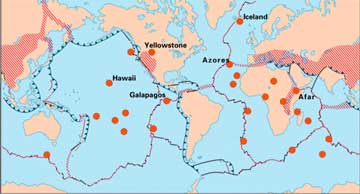THE NATURAL ENVIRONMENT
Geography 101
ToC
EARTH
Geomorph
Interior
Plates
History
Hot Spots
Hot Spots
|
|
BOX 1 |
Most volcanic and earthquake activity around the globe occurs at the boundaries of tectonic plates. Notable exceptions occur, however, at locations geologists refer to as hot spots. Hot spots are areas where fixed plumes of magma rise from the upper mantle. They are not related to plate tectonic movements.
 As
lithospheric plates slide over underlying hot spots, plumes of magma
melt their way to the surface as shown in the diagram. This can produce
volcanism at central locations at the plate's surface.
As
lithospheric plates slide over underlying hot spots, plumes of magma
melt their way to the surface as shown in the diagram. This can produce
volcanism at central locations at the plate's surface.
The Hawaiian Islands are a classic example. The active hot spot lies near the center of the Pacific plate, under the southeastern end of the Island chain. The rising magma plumes and subsequent eruptions have created the Island chain.
As noted in the previous section, the Pacific plate is moving toward the northwest in the Hawaiian Islands region. This motion carries newly created islands toward the northwest and away from the rising magma source. When they travel beyond the hot spot magma plumes, the Islands stop growing and become dormant passengers on the moving tectonic plate.
Thus, the rocks that formed each Island become progressively older with distance from the hot spot location, as shown in the diagram. Of course, Big Island rocks are still being created. On west Maui, Lana'i, and Moloka'i, rocks are between 1 and 2 million years old. On O'ahu, they are between 2 and 4 million years old, and on Kaua'i and Ni'ihau, they are five million years old. In other words, it has taken Kaua'i 5 million years to move to its present location from the hot spot under the today's Big Island.
 The long chain of islands stretching to the northwest from the present hot spot location shows that this process has continued for many tens of millions of years.
The long chain of islands stretching to the northwest from the present hot spot location shows that this process has continued for many tens of millions of years.
The northwest Hawaiian Islands stretch another 2000 kilometers (1250 miles) beyond Kaua'i as far as Midway and Kure, where rocks have been dated to 27 million years old.
Beyond Midway, a chain of underwater seamounts, or underwater mountains, extends all the way to Asia. All of these seamounts were formed by volcanism from the hot spot now located under the Big Island.
This chain of underwater mountains, called the Emperor Seamount chain, is a prominent feature of any sea floor map. (Refer to Marie Tharp's sea floor map in the Plates section.)
An interesting feature of the Emperor Seamounts is the bend, which dates to about 43 million years ago. Earlier than that, the island chain stretched almost due north. Can you think of a reason why the chain of islands would suddenly change direction? Most geologists believe that the Pacific plate itself changed direction at that time. In other words, before 43 million years ago, the Pacific plate moved northward, rather than to the northwest as it does today.
Recent research suggests that the hot spot itself may have moved. Samples from seamounts indicate that the hotspot moved southward between 81 and 47 million years ago, then abruptly slowed and perhaps even stopped. The notion that hot spots move is still speculative.
Many hot spots speckle the Earth besides the one that created the Hawaiian Islands. The map below shows some of the their general locations.
